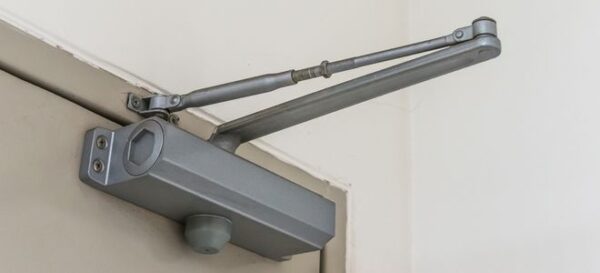Welcome to the ultimate guide on choosing the right hydraulic door closer for your home! If you’ve ever struggled with a stubbornly swinging door, or found yourself battling against strong gusts of wind trying to keep your entrance closed, then you know just how important it is to have a reliable and effective door closer. A hydraulic door closer can be the perfect solution, providing a smooth and controlled closing action that ensures your doors remain securely shut. In this comprehensive guide, we will explore everything you need to know about hydraulic door closers – from understanding their different types and factors to consider when selecting one, to installation tips and troubleshooting common issues. So let’s get started on finding the perfect fit for your home!
What is a Hydraulic Door Closer?
A hydraulic door closer is a device that is installed on a door to automatically close it after it has been opened. It uses hydraulic fluid to control the speed and force of the closing action, ensuring a smooth and controlled movement. This mechanism makes it an ideal choice for both residential and commercial settings.
One of the key advantages of a hydraulic door closer is its ability to adjust the closing speed and latching strength. This means you can customize it based on your specific needs – whether you prefer a quick or slow closing speed, or if you want the door to latch firmly or more softly.
Hydraulic door closers come in various types, including surface-mounted, concealed, and overhead closers. Surface-mounted closers are the most common type as they are easy to install and maintain. Concealed closers offer a sleeker appearance as they are hidden within the frame or floor of the door. Overhead closers are typically used for heavy-duty applications such as commercial doors.
When selecting a hydraulic door closer for your home, consider factors such as door size and weight, desired closing speed, location (indoor or outdoor), traffic volume, and any ADA compliance requirements. Taking these factors into account will help ensure that you choose a closer that meets your specific needs.
In terms of installation and maintenance tips, always follow manufacturer guidelines for proper installation techniques. Regularly inspect your hydraulic closer for any signs of wear or damage, such as leaks in the fluid seals or loose mounting screws. Lubricating moving parts periodically can also help prolong its lifespan.
With all its benefits comes some potential issues with hydraulic door closers too! Stay tuned as we dive into common issues faced by users in our next section!
Remember: choosing the right hydraulic door closer requires careful consideration of various factors unique to your home’s layout and usage patterns.
Types of Hydraulic Door Closers
When it comes to choosing the right hydraulic door closer for your home, understanding the different types available is essential. Let’s take a closer look at some of the options you have:
1. Surface-Mounted Closer: This type of door closer is installed on the surface of the door and frame. It offers excellent versatility and can be used on both interior and exterior doors.
2. Overhead Concealed Closer: As the name suggests, this closer is concealed within the frame header and top rail of the door. It provides a clean and streamlined appearance, making it ideal for commercial settings or modern homes.
3. Floor-Mounted Closer: Typically used in heavy-duty applications, floor-mounted closers are installed into either the floor or threshold below the door. They offer exceptional control over larger and heavier doors.
4. Transom Closer: These closers are designed specifically for glass storefronts or doors with transom windows above them. They provide an elegant solution while maintaining functionality.
5. Electromagnetic Hold-Open Closer: This type of closer uses an electromagnet to hold the door open until released by a fire alarm or other triggering mechanism.
Each type has its own unique features and advantages, so consider factors such as aesthetics, security needs, usage patterns, and budget when selecting your hydraulic door closer.
Factors to Consider When Choosing a Hydraulic Door Closer
When it comes to choosing the right hydraulic door closer for your home, there are several important factors to consider. First and foremost is the weight of your door. Different door closers have different weight capacities, so you’ll need to make sure that the one you choose can handle the weight of your specific door.
Another factor to consider is the size and type of your door. Is it a standard interior door or an exterior entrance? Does it swing inwards or outwards? These details will help determine which type of hydraulic closer will work best for your needs.
You should also think about the level of control you want over the closing speed and strength of your door. Some closers offer adjustable settings, allowing you to customize these aspects based on personal preference or specific circumstances.
Consider whether noise level is a concern for you. Some hydraulic closers operate silently while others may produce more noise during operation. If peace and quiet is important in your home, look for a closer with sound-dampening features.
Don’t forget about aesthetics. While functionality should be top priority when choosing a hydraulic closer, it’s also worth considering how well it blends with your overall decor style.
By taking these factors into consideration, you’ll be able to choose the right hydraulic door closer that meets both practical and aesthetic requirements for your home without compromising on quality or performance!
Installation and Maintenance Tips
Installing a hydraulic door closer is relatively straightforward, but it’s essential to follow the manufacturer’s instructions carefully. Start by gathering all the necessary tools and materials before beginning the installation process. This will save you time and ensure a smooth installation.
First, check if your door is compatible with a hydraulic door closer. Measure the width of your door to determine which size closer you need. It’s important to choose a closer that matches your door’s weight and size for optimal performance.
Next, position the closer on the top jamb or hinge side of the door according to the manufacturer’s recommendations. Use a pencil or marker to mark where you’ll need to drill pilot holes for mounting screws.
Once you’ve marked the spots for drilling, use an appropriate drill bit size for your screws and carefully create pilot holes in the designated areas. Attach the hydraulic arm or slide bar securely using provided screws.
After installing, make sure that there is enough clearance between any obstructions (such as walls or furniture) and both ends of the swing path of your door. This ensures that there won’t be any interference when opening or closing it.
To maintain your hydraulic door closer, regularly inspect it for any signs of wear or damage such as leaking fluid or loose components. If you notice any issues, consult with a professional technician who can assess and repair them properly.
In terms of regular maintenance tasks, periodically lubricate moving parts with silicone spray lubricant to ensure smooth operation. Additionally, keep an eye out for debris buildup around hinges and clean them thoroughly if necessary.
By following these installation tips and practicing regular maintenance routines, you can extend the lifespan of your hydraulic door closer while ensuring reliable functionality throughout its usage cycle!
Common Issues with Hydraulic Door Closers and How to Fix Them
- Door Slamming Shut: One common issue with hydraulic door closers is the door slamming shut instead of closing smoothly. This can be caused by an incorrect adjustment of the spring tension or a damaged closer mechanism. To fix this, start by checking the closer’s adjustment screws and ensuring they are set correctly. If that doesn’t solve the problem, it may be necessary to replace the closer entirely.
2. Slow Closing Speed: Another issue you might encounter is a hydraulic door closer that closes too slowly, leaving your door partially open for longer than desired. In most cases, this can be remedied by adjusting the closing speed valve located on the body of the closer itself. Turn it clockwise to increase closing speed or counterclockwise to decrease it until you achieve the desired result.
3. Leaking Hydraulic Fluid: A leaking hydraulic fluid is another commonly encountered problem with these closers. It often occurs due to worn-out seals or gaskets within the device. To fix this issue, you will need to disassemble your hydraulic closer and replace any damaged seals or gaskets using a seal kit specifically designed for your model.
4. Noisy Operation: If your hydraulic door closer makes loud squeaking or grinding noises when opening or closing, it could indicate insufficient lubrication in its internal components. Applying silicone-based lubricant directly onto moving parts such as hinges and pivot points should help eliminate these annoying sounds.
5. Misaligned Installation: Sometimes, an improperly installed hydraulic door closer can lead to issues like uneven closing or difficulty in opening/closing doors smoothly. Ensure proper alignment during installation so that all components work together seamlessly.
Remember that if you’re not confident in fixing these issues yourself, it’s always best to consult a professional locksmith or technician who specializes in handling hydraulic door closers.
Conclusion
Choosing the right hydraulic Door closer in India for your home is crucial for ensuring safety, convenience, and efficient operation. By understanding the different types of hydraulic door closers available, considering important factors such as size and weight capacity, and following proper installation and maintenance tips, you can find the perfect door closer to meet your needs.
Remember to assess the specific requirements of your doors before making a purchase. Consider factors such as whether you need a surface-mounted or concealed model, what type of mounting options are available, and if any additional features like adjustable closing speed or hold-open functions are necessary.
Proper installation is key to ensure optimal performance. Make sure to follow manufacturer’s instructions carefully and seek professional help if needed. Regular maintenance should also be performed to keep your hydraulic door closer in top condition. Lubricate hinges regularly, inspect for wear or damage, and adjust settings as required.
If you encounter common issues with your hydraulic door closer such as leaking fluid or inconsistent closing speed, don’t panic! Many problems can be easily fixed by adjusting valves or replacing worn-out parts. Refer to manufacturer’s troubleshooting guide or consult a professional if needed.





